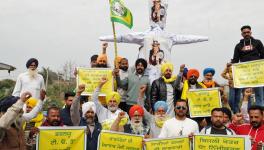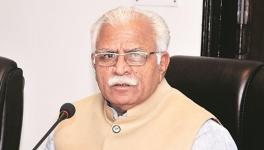More Support for Protest Against Azamgarh Airport Expansion Which Will Displace 10,000 Villagers
Image Courtesy: National Herald
Delhi: Since last month, the protest by locals against the proposed expansion of Mandauri airstrip in Azamgarh, Uttar Pradesh, has been going strong, drawing support from farm leaders and social activists.
There is a proposal to expand the Azamgarh airstrip to an international airport under the UDAN scheme. The project will displace about ten thousand people from around 600 acres of land covering nine villages, including Hasanpur, Kadipur Harikesh, Jamua Hariram, Jamua Jolha, Gadanpur Chindan Patti, Manduri, Jigina Karampur and Jehra Pipri, according to a report by the Counterview. This land in question includes vast stretches of fertile farmland.
The protest, which has now completed 33 days, has seen massive participation from the villagers, a large number of whom are reportedly Dalits and Other Backward Classes (OBCs). They are unwilling to give up their land and livelihoods tied to the land, as NewsClick has reported before.
Ramnayan Yadav, president of the ‘Makan Bachai Khet Bachao Sanyukta Morcha’, which was formed to lead the protest, told the Times of India that the agitation started in September after Dalits of Jamua Hariram village were allegedly harassed during a land survey for the acquisition. He added that the village women further intensified the resistance.
Yadav told the newspaper that the protesters met with the District Magistrate of Azamgarh, Vishal Bhardwaj, to request the withdrawal of the proposal to expand the airstrip and action to be taken against the officials who allegedly harassed Dalits and women during the survey. However, it did not bear any fruit.
According to the DM Azamgarh, who termed the protests as “politically motivated”, the airstrip expansion will require around 310 acres in the first phase and 264 acres in the second phase, affecting 783 houses across the nine villages, the Times of India reported. He said these figures emerged after the survey, which was mired in
controversy.
Local newspapers have reported that the district administration had conducted a survey and submitted its report to the government. However, villagers have reportedly raised questions over how the survey took place when they have not allowed or participated in any survey.
As per the Counterview report, the district administration tried to get a survey done surreptitiously on the night of 12-13 October, and villagers opposed it. They asked the officials what the need for the survey was when they did not want to give up the land. However, during this confrontation, the police accompanying the revenue officials allegedly misbehaved with the women.
Further, Gram Pradhans were also pressurised in this regard, the villagers told Counterview. The Gram Pradhan of Jamua Hariran was allegedly threatened with false cases and made to sit at the police station while the survey was attempted in the villages, the report said. Another day, the police tried to carry him away in a jeep when the women encircled the vehicle and did not allow it to leave the village. The police then had to let him go, Counterview reported.
The reported coercion during the survey process has further riled the people in Azamgarh. Their relentless protest has drawn solidarity from various sides, and farmer leader Rakesh Tikait, social activist and Narmada Bachao Andolan leader Medha Patkar, social activist Arundhati Dhuru etc. went to Azamgarh protest side in a show of their support.
Addressing a gathering there on November 8, Patkar said efforts were being made to take away the land forcibly, and the UP government and local administration were overlooking provisions of the Land Acquisition Act, 2013, which mandates seeking consent from 80% of land owners before the land is taken by the government, the Times of India reported.
Arriving in Jamua village on November 9, Tikait lent solidarity to the protest and said “If farmers won’t agree to sell their land, nobody can acquire it forcibly.” He told the farmers to stand their ground and not get swayed by the administration. “Who will benefit from the expansion of the airstrip is not known, but the future of farmers will definitely be spoiled after they lose their land,” he said, according to the Times of India.
People from Azamgarh often go to different parts of the country and abroad to find work. Basdeo Panday, the descendent of an indentured labourer family from Azamgarh who migrated to Trinidad and Tobago, had even become the Prime Minister of Trinidad and Tobago. But most of the people who migrated from Azamgarh in the past did not use an airport, because a large part of the population is poor and can mostly avail of train travel. Hence, what the majority of people here require is more trains and coaches to travel comfortably, the Counterview reported.
People of the affected villages have been questioning the need for this airport when there are international airports in Varanasi,Kushinagar, Gorakhpur, Ayodhya and now even Lucknow. Moreover, the distance to Lucknow airport has been reduced to 2.5 hours from Azamgarh because of the newly constructed Purvanchal Expressway. The Varanasi airport is also two hours journey away from the district. The protesters also slammed the government’s choice of acquiring highly fertile land for the expansion project.
Get the latest reports & analysis with people's perspective on Protests, movements & deep analytical videos, discussions of the current affairs in your Telegram app. Subscribe to NewsClick's Telegram channel & get Real-Time updates on stories, as they get published on our website.
























